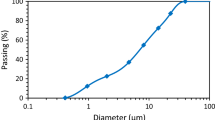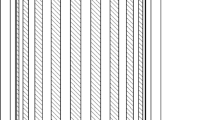Abstract
The determination of the yield stress (τ0) of cement-based materials is of great interest for engineering applications, since it accurately describes the flow behavior and assesses empirical properties related to its workability, such as the slump of concretes and the spreading of mortars. In this work, the τ0 of cement pastes was determined by different methods. Specifically, pastes with three different water/cement ratios and two supplementary cementitious materials in Portland cement replacement were produced. The mini slump of the pastes was measured, and its static τ0 and dynamic τ0 were determined by rotational rheometry. In addition, small amplitude oscillatory shear (SAOS) was used to further investigate the rigidification rate of the pastes over time, providing valuable information for the discussion. The results showed that the dynamic τ0 values provided by the different rheological models showed strong correlations. However, these values had weaker correlations with the static τ0. The rest period between the finish of the pre-shear and the test run strongly affected the magnitude of the stress overshoot and therefore the static τ0 value. SAOS indicated that the decrease in the inter-particle distance increased the rigidification rate of the paste within the first minute after mixing, which may affect the mini slump results. Finally, the use of the mini slump as a single test to generally evaluate cement pastes with wide ranges of flowability may not be adequate, in line with the existence of different tests for the evaluation of conventional and self-compacting concretes.

















Similar content being viewed by others
References
Ferraris CF, Brower LE (2003) Comparison of concrete rheometers. Concr Int 25:41–47. https://doi.org/10.1016/j.dss.2006.10.003
Roussel N, Lemaître A, Flatt RJ, Coussot P (2010) Steady state flow of cement suspensions: a micromechanical state of the art. Cem Concr Res 40:77–84. https://doi.org/10.1016/j.cemconres.2009.08.026
Chang C, Boger DV (1998) The yielding of waxy crude oils. Ind Eng Chem Res 37:1551–1559. https://doi.org/10.1021/ie970588r
Banfill PFG (2011) Additivity effects in the rheology of fresh concrete containing water-reducing admixtures. Constr Build Mater 25:2955–2960. https://doi.org/10.1016/j.conbuildmat.2010.12.001
Laskar AI, Bhattacharjee R (2011) Torque-speed relationship in a concrete rheometer with vane geometry. Constr Build Mater 25:3443–3449. https://doi.org/10.1016/j.conbuildmat.2011.03.035
Rahman MK, Baluch MH, Malik MA (2014) Thixotropic behavior of self compacting concrete with different mineral admixtures. Constr Build Mater 50:710–717. https://doi.org/10.1016/j.conbuildmat.2013.10.025
Saleh Ahari R, Kemal Erdem T, Ramyar K (2015) Effect of various supplementary cementitious materials on rheological properties of self-consolidating concrete. Constr Build Mater 75:89–98. https://doi.org/10.1016/j.conbuildmat.2014.11.014
Roussel N (2006) Correlation between yield stress and slump: comparison between numerical simulations and concrete rheometers results. Mater Struct Constr 39:501–509. https://doi.org/10.1617/s11527-005-9035-2
Roussel N (2007) Rheology of fresh concrete: from measurements to predictions of casting processes. Mater Struct 40:1001–1012. https://doi.org/10.1617/s11527-007-9313-2
Roussel N, Stefani C, Leroy R (2005) From mini-cone test to Abrams cone test: measurement of cement-based materials yield stress using slump tests. Cem Concr Res 35:817–822. https://doi.org/10.1016/j.cemconres.2004.07.032
Gao J, Fourie A (2015) Spread is better: an investigation of the mini-slump test. Miner Eng 71:120–132. https://doi.org/10.1016/j.mineng.2014.11.001
Gao J, Fourie A (2015) Using the flume test for yield stress measurement of thickened tailings. Miner Eng 81:116–127. https://doi.org/10.1016/j.mineng.2015.07.013
Schwartzentruber LDA, Le Roy R, Cordin J (2006) Rheological behaviour of fresh cement pastes formulated from a self compacting concrete (SCC). Cem Concr Res 36:1203–1213. https://doi.org/10.1016/j.cemconres.2004.10.036
Pashias N, Boger DV, Summers J, Glenister DJ (1996) A fifty cent rheometer for yield stress measurement. J Rheol (N. Y. N. Y) 40:1179–1189. https://doi.org/10.1122/1.550780
Wallevik OH, Feys D, Wallevik JE, Khayat KH (2015) Avoiding inaccurate interpretations of rheological measurements for cement-based materials. Cem Concr Res 78:100–109. https://doi.org/10.1016/j.cemconres.2015.05.003
Roy DM, Asaga K (1979) Rheological properties of cement mixes: III. The effects of mixing procedures on viscometric properties of mixes containing superplasticizers. Cem Concr Res 9:731–739. https://doi.org/10.1016/0008-8846(79)90068-1
Han D, Ferron RD (2016) Influence of high mixing intensity on rheology, hydration, and microstructure of fresh state cement paste. Cem Concr Res 84:95–106. https://doi.org/10.1016/j.cemconres.2016.03.004
de França MS, Cazacliu B, Cardoso FA, Pileggi RG (2019) Influence of mixing process on mortars rheological behavior through rotational rheometry. Constr Build Mater 223:81–90. https://doi.org/10.1016/j.conbuildmat.2019.06.213
Assaad JJ, Harb J, Maalouf Y (2014) Measurement of yield stress of cement pastes using the direct shear test. J Nonnewton Fluid Mech 214:18–27. https://doi.org/10.1016/j.jnnfm.2014.10.009
Cardoso FA, Fujii AL, Pileggi RG, Chaouche M (2015) Parallel-plate rotational rheometry of cement paste: Influence of the squeeze velocity during gap positioning. Cem Concr Res 75:66–74. https://doi.org/10.1016/j.cemconres.2015.04.010
Mbasha W, Masalova I, Haldenwang R, Malkin A (2015) The yield stress of cement pastes as obtained by different rheological approaches. Appl Rheol 25:1–11. https://doi.org/10.3933/APPLRHEOL-25-53517
Bala M, Zentar R, Boustingorry P (2019) Comparative study of the yield stress determination of cement pastes by different methods. Mater Struct. https://doi.org/10.1617/s11527-019-1403-4
Roussel N, Le Roy R, Coussot P (2004) Thixotropy modelling at local and macroscopic scales. J Nonnewton Fluid Mech 117:85–95. https://doi.org/10.1016/j.jnnfm.2004.01.001
De la Varga I, Castro J, Bentz DP, Zunino F, Weiss J (2018) Evaluating the hydration of high volume fly ash mixtures using chemically inert fillers. Constr Build Mater 161:221–228. https://doi.org/10.1016/j.conbuildmat.2017.11.132
Felekoğlu B (2014) Rheological behaviour of self-compacting micro-concrete. Sadhana Acad Proc Eng Sci 39:1471–1495. https://doi.org/10.1007/s12046-014-0281-2
Sonebi M, Lachemi M, Hossain KMA (2013) Optimisation of rheological parameters and mechanical properties of superplasticised cement grouts containing metakaolin and viscosity modifying admixture. Constr Build Mater 38:126–138. https://doi.org/10.1016/j.conbuildmat.2012.07.102
Roussel N, Coussot P (2005) “Fifty-cent rheometer” for yield stress measurements: from slump to spreading flow. J Rheol (N. Y. N. Y) 49:705–718. https://doi.org/10.1122/1.1879041
ABNT, NBR 16697 (2018) Cimento Portland-Requisitos 12
de Matos PR, Prudêncio LR, de Oliveira AL, Pelisser F, Gleize PJP (2018) Use of porcelain polishing residue as a supplementary cimentitious material in self-compacting concrete. Constr Build Mater 193:623–630. https://doi.org/10.1016/j.conbuildmat.2018.10.228
de Matos PR, de Oliveira AL, Pelisser F, Prudêncio LR (2018) Rheological behavior of Portland cement pastes and self-compacting concretes containing porcelain polishing residue. Constr Build Mater 175:508–518. https://doi.org/10.1016/j.conbuildmat.2018.04.212
Yuan Q, Zhou D, Khayat KH, Feys D, Shi C (2017) On the measurement of evolution of structural build-up of cement paste with time by static yield stress test vs. small amplitude oscillatory shear test. Cem Concr Res 99:183–189. https://doi.org/10.1016/j.cemconres.2017.05.014
Kantro DL (1980) Influence of water-reducing admixtures on properties of cement paste: a miniature slump test. Cem. Concr. Agreg. 2:95–102. https://doi.org/10.1520/CCA10190J
Roussel N (2006) A thixotropy model for fresh fluid concretes: theory, validation and applications. Cem Concr Res 36:1797–1806. https://doi.org/10.1016/j.cemconres.2006.05.025
Yahia A, Khayat KH (2001) Analytical models for estimating yield stress of high-performance pseudoplastic grout. Cem Concr Res 31:731–738. https://doi.org/10.1016/S0008-8846(01)00476-8
Mostafa AM, Yahia A (2016) New approach to assess build-up of cement-based suspensions. Cem Concr Res 85:174–182. https://doi.org/10.1016/j.cemconres.2016.03.005
Yahia A, Tanimura M (2015) Rheology of belite-cement: effect of w/c and high-range water-reducer type. Constr Build Mater 88:169–174. https://doi.org/10.1016/j.conbuildmat.2015.03.029
Cheng DC-H (1986) Yield stress: a time-dependent property and how to measure it. Rheol Acta 554:542–554. https://doi.org/10.1007/BF01774406
Qian Y, Kawashima S (2018) Distinguishing dynamic and static yield stress of fresh cement mortars through thixotropy. Cem Concr Compos 86:288–296. https://doi.org/10.1016/j.cemconcomp.2017.11.019
Bentz DP, Ferraris CF, Galler MA, Hansen AS, Guynn JM (2012) Influence of particle size distributions on yield stress and viscosity of cement-fly ash pastes. Cem Concr Res 42:404–409. https://doi.org/10.1016/j.cemconres.2011.11.006
Liddell V (1996) Yield stress measurements with the vane. J Non-Newton Fluid Mech 63:235–261
Nguyen QD, Boger DV (1992) Measuring the flow properties of yield stress fluids. Annu Rev Fluid Mech 24:47–88. https://doi.org/10.1146/annurev.fl.24.010192.000403
Medina-Bañuelos EF, Marín-Santibáñez BM, Pérez-González J, Kalyon DM (2019) Rheo-PIV analysis of the vane in cup flow of a viscoplastic microgel. J Rheol (NYNY) 63:905–915. https://doi.org/10.1122/1.5118900
Perrot A, Lecompte T, Khelifi H, Brumaud C, Hot J, Roussel N (2012) Yield stress and bleeding of fresh cement pastes. Cem Concr Res 42:937–944. https://doi.org/10.1016/j.cemconres.2012.03.015
Roussel N, Ovarlez G, Garrault S, Brumaud C (2012) The origins of thixotropy of fresh cement pastes. Cem Concr Res 42:148–157. https://doi.org/10.1016/j.cemconres.2011.09.004
Overlaz G (2012) Introduction to the rheometry of complex suspensions. In: Roussel N (ed) Understanding the rheology of concrete. Woodhead Publishing Limited, Cambridge, p 364
Coussot P (2005) Rheometry of pastes, suspensions, and granular materials: applications in industry and environment. Wiley, Hoboken
Jiao D, Shi C, Yuan Q (2019) Time-dependent rheological behavior of cementitious paste under continuous shear mixing. Constr Build Mater 226:591–600. https://doi.org/10.1016/j.conbuildmat.2019.07.316
Huang T, Li B, Yuan Q, Shi Z, Xie Y, Shi C (2019) Rheological behavior of Portland clinker-calcium sulphoaluminate clinker- anhydrite ternary blend. Cem Concr Compos 104:103403. https://doi.org/10.1016/j.cemconcomp.2019.103403
Yahia A (2014) Effect of solid concentration and shear rate on shear-thickening response of high-performance cement suspensions. Constr Build Mater 53:517–521. https://doi.org/10.1016/j.conbuildmat.2013.10.078
Vance K, Sant G, Neithalath N (2015) The rheology of cementitious suspensions: a closer look at experimental parameters and property determination using common rheological models. Cem Concr Compos 59:38–48. https://doi.org/10.1016/j.cemconcomp.2015.03.001
Bingham EC (1922) Fluidity and plasticity. Mcgraw-Hill Book Company Inc., New York
Herschel WH, Bulkley R (1926) Measurement of consistency as applied to rubber-benzene solutions. Am Soc Test Proc 26:621–633
Feys D, De Schutter G, Verhoeven R (2013) Parameters influencing pressure during pumping of self-compacting concrete. Mater Struct 46:533–555. https://doi.org/10.1617/s11527-012-9912-4
Ma K, Feng J, Long G, Xie Y (2016) Effects of mineral admixtures on shear thickening of cement paste. Constr Build Mater 126:609–616. https://doi.org/10.1016/j.conbuildmat.2016.09.075
Guo Y, Zhang T, Wei J, Yu Q, Ouyang S (2017) Evaluating the distance between particles in fresh cement paste based on the yield stress and particle size. Constr Build Mater 142:109–116. https://doi.org/10.1016/j.conbuildmat.2017.03.055
Zhao M, Zhang X, Zhang Y (2016) Effect of free water on the flowability of cement paste with chemical or mineral admixtures. Constr Build Mater 111:571–579. https://doi.org/10.1016/j.conbuildmat.2016.02.057
Kim JH, Kwon SH, Kawashima S, Yim HJ (2017) Rheology of cement paste under high pressure. Cem Concr Compos 77:60–67. https://doi.org/10.1016/j.cemconcomp.2016.11.007
Shanahan N, Tran V, Williams A, Zayed A (2016) Effect of SCM combinations on paste rheology and its relationship to particle characteristics of the mixture. Constr Build Mater 123:745–753. https://doi.org/10.1016/j.conbuildmat.2016.07.094
Barnes HA, Nguyen QD (2001) Rotating vane rheometry: a review. J Nonnewton Fluid Mech 98:1–14. https://doi.org/10.1016/S0377-0257(01)00095-7
Divoux T, Mannevilleac C, Sébastien B (2011) Stress overshoot in a simple yield stress fluid: an extensive study combining rheology and velocimetry. Soft Matter 7:9335–9349. https://doi.org/10.1039/C1SM05740E
Dimitriou CJ, Mckinley GH, Venkatesan R (2011) Rheo-PIV analysis of the yielding and flow of model waxy crude oils. Energy Fuels 25:3040–3052. https://doi.org/10.1021/ef2002348
Baldino N, Gabriele D, Lupi FR, Seta L, Zinno R (2014) Rheological behaviour of fresh cement pastes: influence of synthetic zeolites, limestone and silica fume. Cem Concr Res 63:38–45. https://doi.org/10.1016/j.cemconres.2014.04.009
de Larrard F, Ferraris CF, Sedran T (1998) Fresh concrete: a HerscheI–Bulkley material. Mater Struct 31:494–498. https://doi.org/10.1007/BF02480474
Acknowledgments
The authors acknowledge the following Brazilian governmental research agencies for the financial support: National Council for Scientific and Technological Development (CNPq); Coordination for the Improvement of Higher Education Personnel (CAPES); Santa Catarina Research Foundation (FAPESC). We also would like to acknowledge the staff of the Central Laboratory of Electronic Microscopy (LCME-UFSC) for their assistance, and professor Rafael Giuliano Pileggi (Escola Politécnica-USP) for the insightful discussion that motivated this research. The two anonymous reviewers are gratefully acknowledged for their invaluable contributions.
Author information
Authors and Affiliations
Corresponding author
Ethics declarations
Conflict of interest
The authors certify that they have NO affiliations with or involvement in any organization or entity with any financial interest (such as honoraria; educational grants; participation in speakers’ bureaus; membership, employment, consultancies, stock ownership, or other equity interest; and expert testimony or patent-licensing arrangements) or non-financial interest (such as personal or professional relationships, affiliations, knowledge or beliefs) in the subject matter or materials discussed in this manuscript.
Additional information
Technical Editor: Edson José Soares, PhD.
Publisher's Note
Springer Nature remains neutral with regard to jurisdictional claims in published maps and institutional affiliations.
Rights and permissions
About this article
Cite this article
de Matos, P.R., Pilar, R., Casagrande, C.A. et al. Comparison between methods for determining the yield stress of cement pastes. J Braz. Soc. Mech. Sci. Eng. 42, 24 (2020). https://doi.org/10.1007/s40430-019-2111-2
Received:
Accepted:
Published:
DOI: https://doi.org/10.1007/s40430-019-2111-2




